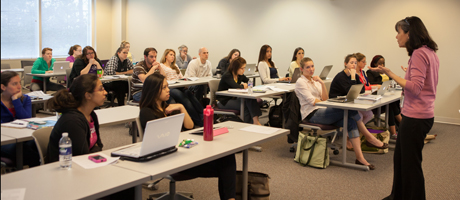A new blended-learning format gives more flexibility to students.
July 9, 2012
It takes GW nursing student Brittany Wilson about an hour to drive from her home in Manassas, Va. to GW’s School of Nursing (SON) on the Virginia Science and Technology Campus.
But thanks to a $655,000 grant from the U.S. Department of Health and Human Services’ Health Resources and Services Administration, Ms. Wilson gets to stay home once a month in her pajamas and watch a recorded lecture online instead of driving to campus and attending class in-person.
The project – Teaching and Transforming through Technology (nicknamed “T3”) –is allowing GW to integrate an array of technologies with classroom experiences for nursing students. The T3 project will help move GW’s Bachelor of Science in Nursing (BSN) program away from a solely face-to-face delivery into a blended-learning model – one that uses a combination of traditional and new media methods.
“Blended learning will provide students with more flexibility and easier access to course materials,” said SON Dean Jean Johnson. “We believe it will be more effective and will enable students to spend less time on campus.”
Ms. Wilson, who is enrolled in GW’s accelerated BSN program, said the new blended-learning format has been really beneficial. Not only does it make her commute more manageable, but because the lectures are posted online, she can review them as many times as she needs to reinforce difficult concepts. Then once she has a grasp of the material, Ms. Wilson contributes to the class’s online discussion board.
“The workload for the accelerated BSN program is fairly heavy, and I wanted them to have a little freedom to control when they wanted to review the lectures and post on the discussion board without them having to physically be in class,” said Rebecca Mance, a SON clinical education instructor. “One of the greatest benefits to the students is having access to the material anytime.”
Laurie Posey, director of instructional design and a SON assistant professor, said one of the goals of the grant is to identify ways to educate more nurses from underserved areas and increase diversity in the nursing workforce. Because GW’s accelerated BSN program attracts students from across Virginia, D.C. and Maryland, some students have a commute of 30 miles or more.
SON reviewed each course in the accelerated BSN program to determine how technology could best be integrated with classroom activities to optimize learning, Ms. Posey said. Technology-based learning experiences include pre-recorded lectures, online case studies, interactive learning modules, webinars, collaborative wikis, blogs and learner-response systems in the classroom.
Nursing student Alex Rose said he feels more prepared for class by being able to review the lecture online in advance.
“We already know what the professor thinks is most important so we’re already one step ahead of the game and can come to class prepared and get more out of our class time,” said Mr. Rose.
Jacqueline Wavelet, a SON clinical educator instructor, said this format allows for more active learning and thus more effective use of class time. Ms. Wavelet uses case studies, group work and critical thinking exercises to reinforce the pre-recorded lecture. She routinely poses a question to the class and has students answer using a clicker.
“If the answers are scattered across the board, that will show me there’s not clear understanding of the topic, and it shows me in real time that I need to intervene,” she said. “It allows me to do more dynamic teaching.”
And when it comes time for exams, students find the online components very helpful because they can go back and review any portion of the lectures instead of just having to rely on their notes.
“It relieves a lot of my stress around test time,” said Mr. Rose.


